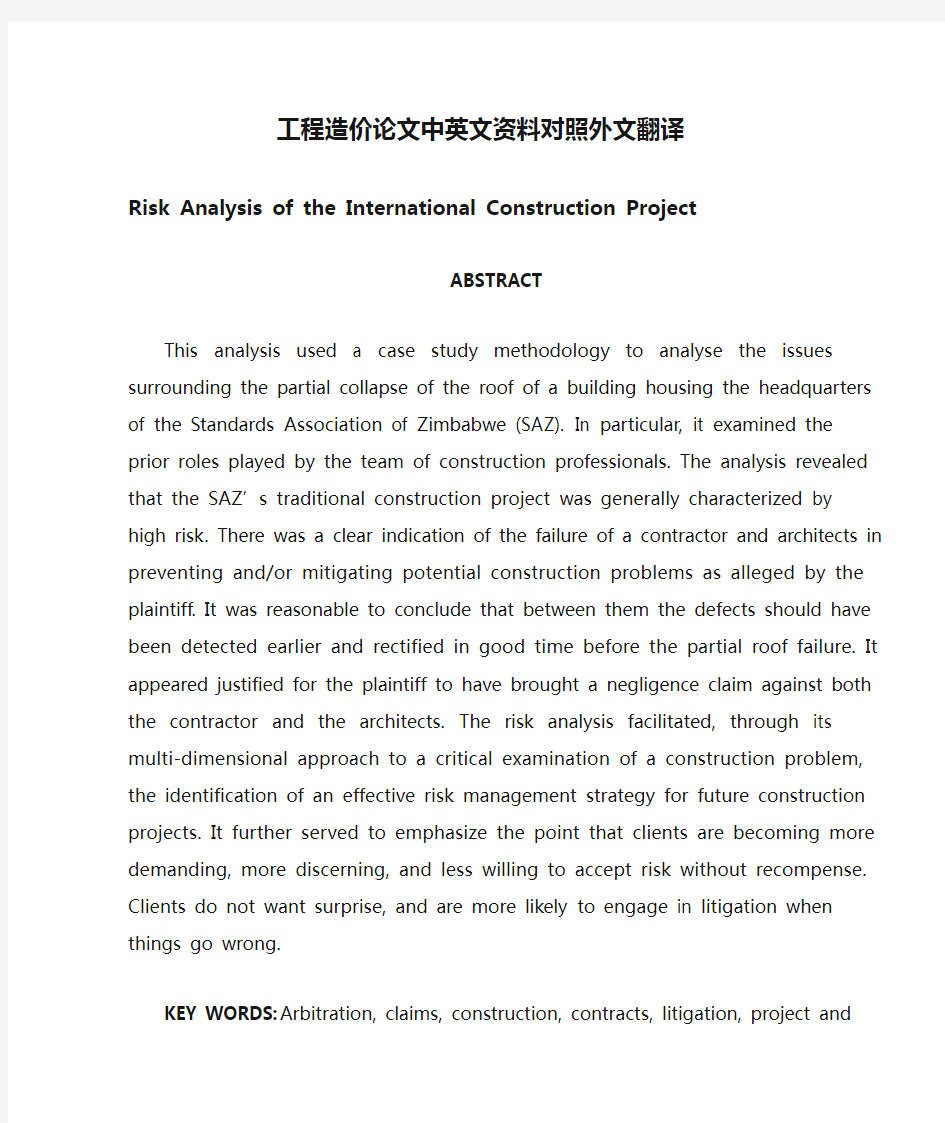
工程造价论文中英文资料对照外文翻译
- 格式:doc
- 大小:50.00 KB
- 文档页数:10


工程造价论文中英文资料对照外文翻译
Risk Analysis of the International Construction Project
ABSTRACT
This analysis used a case study methodology to analyse the issues surrounding the partial collapse of the roof of a building housing the headquarters of the Standards Association of Zimbabwe (SAZ). In particular, it examined the prior roles played by the team of construction professionals. The analysis revealed that the SAZ’s traditional construction project was generally characterized by high risk. There was a clear indication of the failure of a contractor and architects in preventing and/or mitigating potential construction problems as alleged by the plaintiff. It was reasonable to conclude that between them the defects should have been detected earlier and rectified in good time before the partial roof failure. It appeared justified for the plaintiff to have brought a negligence claim against both the contractor and the architects. The risk analysis facilitated, through its multi-dimensional approach to a critical examination of a construction problem, the identification of an effective risk management strategy for future construction projects. It further served to emphasize the point that clients are becoming more demanding, more discerning, and less willing to accept risk without recompense. Clients do not want surprise, and are more likely to engage in litigation when things go wrong.
KEY WORDS:Arbitration, claims, construction, contracts, litigation, project and risk The structural design of the reinforced concrete elements was done by consulting engineers Knight Piesold (KP). Quantity surveying services were provided by Hawkins, Leshnick & Bath (HLB). The contract was awarded to Central African Building Corporation (CABCO) who was also responsible for the provision of a specialist roof structure using patented “gang nail” roof trusses. The building construction proceeded to completion and was handed over to the owners on Sept. 12, 1991. The SAZ took effective occupation of the headquarters building without a certificate of occupation. Also, the defects liability period was only three months .
The roof structure was in place 10 years before partial failure in December 1999. The building insurance coverage did not cover enough, the City of Harare, a government municipality, issued the certificate of occupation 10 years after occupation, and after partial collapse of the roof .
At first the SAZ decided to go to arbitration, but this failed to yield an immediate solution. The SAZ then decided to proceed to litigate in court and to bring a negligence claim against CABCO. The preparation for arbitration was reused for litigation. The SAZ’s quantified losses stood at approximately $ 6 million in Zimbabwe dollars (US $1.2m) .
After all parties had examined the facts and evidence before them, it became clear that there was a great probability that the courts might rule that both the architects and the contractor were liable. It was at this stage that the defendants’ lawyers requested that the matter be settled out of court. The plaintiff agreed to this suggestion, with the terms of the settlement kept confidential .
The aim of this critical analysis was to analyse the issues surrounding the partial collapse of the roof of the building housing the HQ of Standard Association of Zimbabwe. It examined the prior roles played by the project management function and construction professionals in preventing/mitigating potential construction problems. It further assessed the extent to which the employer/client and parties to a construction contract are able to recover damages under that contract. The main objective of this critical analysis was to identify an effective risk management strategy for future construction projects. The importance of this study is its multidimensional examination approach.
Experience suggests that participants in a project are well able to identify risks based on their own experience. The adoption of a risk management approach, based solely in past experience and dependant on judgement, may work reasonably well in a stable low risk environment. It is unlikely to be effective where there is a change. This is because change requires the extrapolation of past experience, which could be misleading. All construction projects are prototypes to some extent and imply change. Change in the construction industry itself suggests that past experience is unlikely to